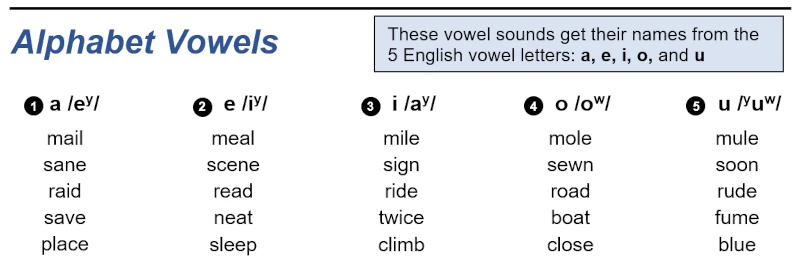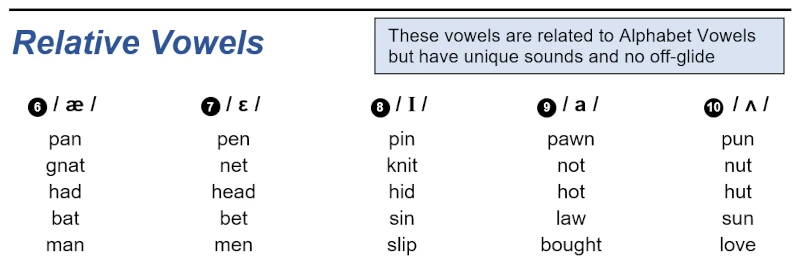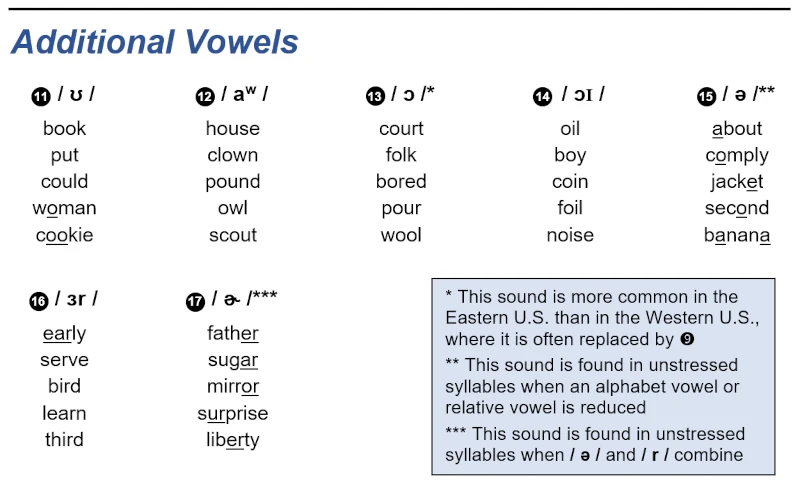English Pronunciation and The Magic of Vowels:
Every language learner knows the uncomfortable feeling: You just started a friendly conversation with a neighbor, coworker, or some other native speaker when their warm smile is suddenly replaced by an empty look of confusion.
They didn’t understand what you said.
This discouraging experience has led many language learners to believe they will never learn to communicate clearly. However, if this is you, don’t lose hope! There is something you can start working on today that will take your conversation to the next level:
Spend time understanding and practicing English vowel sounds.
Why Vowel Sounds Are Magic
In every language, words (and meaning) are built by joining small sounds called vowels and consonants in different ways. What are vowels and consonants?
Vowels are the ‘open mouth’ sounds. When you make a vowel (in any language) the mouth is open and the air is moving freely. In English, vowel sounds include common sounds like a (“eyyy”), o (“ooow”), or u (“yuuw”).
 Consonants, on the other hand, are ‘closed mouth’ sounds. When you make a consonant, you use your lips, tongue, nose, or throat to control or limit the movement of air. In English, consonant sounds include b (closing the lips), g (closing the back of the throat), and s (controlling the movement of air with the front of the tongue).
Consonants, on the other hand, are ‘closed mouth’ sounds. When you make a consonant, you use your lips, tongue, nose, or throat to control or limit the movement of air. In English, consonant sounds include b (closing the lips), g (closing the back of the throat), and s (controlling the movement of air with the front of the tongue).
For people learning American English, certain consonant sounds are famously difficult, especially sounds like l (“ell”), th (“thu”), or r (“ruh”). Every English language learner knows and hates these consonants.
But sometimes, English learners don’t pay enough attention to an equally important group of sounds: the vowels.
Vowels are key to clear pronunciation because they change the meaning of words so quickly.
For example, if you make a mistake with the consonant th and say “I tink so” instead of “I think so,” there is a good chance your conversation partner will understand you. However, if you make a mistake with your vowels and you say “I leave downtown” instead of “I live downtown,” you are going to see a lot of confused looks!
How to Get Started with Vowels
In my teaching, I am often surprised by how many intermediate or advanced English learners were never taught to understand and recognize vowel sounds. They have missed the magic! But it’s never too late to start.
American English has a large number of vowel sounds: around 20 of them. This set of sounds changes in different parts of the United States; some sounds are more popular in the Western U.S. and some more popular in the Eastern. Fortunately, we can all (mostly) understand one another in spite of these regional differences.
In my teaching, I’ve found that there are 17 American English vowel sounds that are most useful for Language Learners to recognize and learn to use.
 Before talking about that, though, it’s important to understand why learning new vowel sounds is so difficult.
Before talking about that, though, it’s important to understand why learning new vowel sounds is so difficult.
First-Language Influence
In our first languages, vowel sounds are often the very first sounds we learn to make. Before babies can form complete words, they begin to use vowels like “ooo” and “aaaah” to communicate. Vowel sounds have a very old and well-constructed home inside our brains.
Learning a new set of vowel sounds means building a new mental house and inviting your brain to spend time there. But your brain doesn’t want to do that—it prefers the old house! Your mouth also doesn’t want to learn new exercises. It would rather stay with its comfortable routine of well-known sounds.
Just like when starting a new kind of sport or physical exercise, your body will be unhappy with your new pronunciation project—at first. Your tongue won’t want to move to new positions. But with repeated practice, these sounds will get more and more familiar, and easier to form.
One final word before introducing the 17 most important American vowel sounds: When it comes to English pronunciation, keep in mind that the goal is not to speak exactly like an American. Not only is that goal unrealistic for most people, but spoken accents are also beautiful; the world would be less interesting without them!
A much better language goal than accent reduction is clear communication. As you develop your understanding of American English vowels, your first language will continue to influence you, and that’s okay. In fact, it is more than okay—it’s great, because it is part of who you are.
The 17 Most Important Vowel Sounds of American English
The system you’re about to see breaks the 17 sounds into 3 different groups. Each group has its own features, and dividing vowels this way helps make them easier to understand, practice, and use in conversation.
I want to give credit to Judy Gilbert, whose excellent book Clear Speech is where I first learned this organizing system for understanding vowel sounds. If you don’t have a copy of Clear Speech, you should definitely get one! You can find a resource link at the end of the article.
Here are the 17 main American English vowel sounds. Each section below also includes an audio track so you can practice along with me:
Group 1: The Alphabet Vowels (Numbers 1-5)
We start with the 5 most familiar vowel sounds, the ones you hear when you say the English alphabet: a, e, i, o, and u. All 5 of these vowels have movement of the tongue inside of them. These tongue movements are very important for helping separate the Alphabet Vowels from some of the other vowels we will see.
The first 3 (a, e, and i) require raising the tongue at the end of the vowel. The tongue should end in a very high position, almost touching the roof of the mouth, and creating a vibration that you can feel.
The last 2 (o and u) end with the lips coming forward—almost like giving a kiss. These motions may be strange at first, but with practice they will become easier.

Listen: The Alphabet Vowels
Group 2: The Relative Vowels (Numbers 6-10)
Each of the 5 Alphabet Vowels has a Relative—a cousin that shares some similarities while also having important differences.
The first difference of the Relative Vowels is that the tongue does not move when you form them; the tongue stays still.
In my experience of working with English Language Learners from many different backgrounds, the Relative Vowels are also more difficult tongue positions for many people to create. They require moving the tongue lower (for numbers 6 and 9) or further back (for numbers 8 and 10) than is comfortable or familiar for many first languages.
Spend time noticing the differences between each sound and comparing the Relative Vowels with the Alphabet Vowels. How are #2 and #8 different? Practice pairs like “meal” and “mill” or “neat” and “knit.” Invite your tongue to try out these new, unfamiliar exercises.
When you’re finished, you can reward your tongue with some chocolate as a thank-you for its hard work.

Listen: The Relative Vowels
Group 3: Additional Vowels (Numbers 11-17)
This third and final group of vowels is formed mainly in two ways: They involve either combining two vowels (called a diphthong) or they involve consonants that change the sound of the vowels.
The exceptions to this are#13 and #15. Number 13 is a single vowel formed by the tongue moving back and the lips coming forward. Number 15 (which I often call American’s Favorite Vowel) is a reduced, neutral sound called ‘schwa.’ Any Alphabet Vowel or Relative Vowel can change to #15 when it is not stressed inside a word.

Listen: Additional Vowels
Spend time with these vowel sounds and it is certain to make a difference in your conversations! You can download a free PDF that I created of all 17 American English Vowel Sounds by clicking here.
Also, be sure to check out Judy Gilbert’s excellent pronunciation resource Clear Speech, 4th Edition (Available here on Amazon).
Thanks for reading about the importance of vowel sounds for English Pronunciation!
If you have a question or a comment, be sure to share it below.
You might also enjoy my article about 4 Steps you can take to have Confident Conversations in English
Also, I have a helpful article you can check out about ways to make new friends in the U.S.
Note: As an Amazon Associate, I earn from qualifying purchases, at no additional cost to you. Recommended resources are carefully selected and help support the operation of my blog, so thank you for clicking!



0 Comments